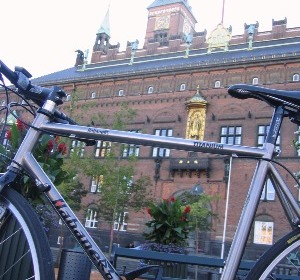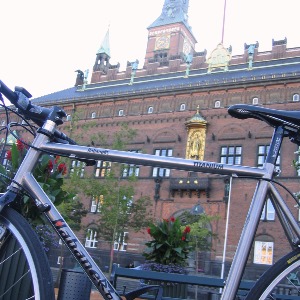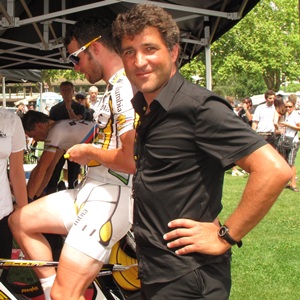Hot as a Habanero

We speak with Mark Hickey, founder of American frame manufacturer, Habanero Cycles. Always thoughtful, pragmatic, and funny, we think you’ll enjoy what he has to say.
Editor’s note: I’ve gotten to know Mark over several years, simply by virtue of us both being (bike) “industry guys”. We originally met over the internet, talked through some bike designs, and I decided his company was the only one in existence that fit all of my criteria (including price and excellent customer service) for the cyclocross frame I had in mind. That was a few years ago – and I now own three of his frames. These were not freebies; I paid my hard-earned dollars for all of them. I ride them regularly, and don’t see any time in the near future that I’d want to sell them. While he’d be the first to tell you that they can’t build an aerodynamic “super bike”, their very complete line and ability to do custom work could very well suit your needs for your next cyclocross bike, mountain bike, crit racer, or whatever your mind conjures and your heart desires.
Slowtwitch: How did Habanero get started? Where does the name come from?
Mark Hickey: Habanero Cycles essentially started in the outskirts of Beijing during a road bike ride with a local Chinese buddy. I was working for a large communications company at the time, and lived in Beijing for a couple years in the early 90’s. I loved the experience because at the time, Beijing was a city with a bicycle culture that was light years ahead (or behind, depending on your outlook) of the US, or pretty much anywhere else. During a water stop, my buddy mentioned that he knew of an aerospace fabrication house that had spun off a private enterprise that was building titanium bike frames, and offered to introduce me. I was interested, but didn’t hold out much hope of finding anything interesting, having seen the state of the Chinese bike manufacturers at the time. That all changed when I visited the fabricator, and saw what they were capable of doing. I’ve always been frugal (aka “cheap”), and knew that there was a market for what they could provide. I’ve been working solely with this fabricator since then.
My wife and I worked out a business plan for the company, and came up with the name on a flight from Beijing to LA on our return trip to the US. I’ve always been a hot food fan, and have been known to eat raw habanero peppers on a dare, or just to satisfy my need for pain (something most cyclists intuitively understand). I named the company to pay homage to the king of hot peppers, and so I could use cheesy taglines like “nothing’s hotter than a Habanero”.

ST: What was your inspiration behind the company and bike design?
Mark: Initially, the big draw was to market a quality titanium frame for well under $1000 – that just wasn’t being done when I started Habanero. I had strong ideas about the geometry and features I wanted to provide. At the time, several titanium builders were giving the material a bad name by trying to shave too many grams, or by trying to make their frames look like steel frames with spindly, tapered stays or too-small tubes. I adopted an “over-design is good design” philosophy, knowing that eliminating lateral flex and evil handling characteristics are worth leaving a few extra grams of material in the design. I opted for slightly oversize straight gauge, seamless aerospace grade tubing because it provided the ride characteristics and stiffness I was looking for at a price point I could use to compete with nice steel frames. I used 3Al/2.5V (titanium alloyed with 3% aluminum and 2.5% vanadium) because it hits that sweet spot in terms of ultimate strength and plasticity (the ability to be deformed without permanent deformation).
My design philosophy is that a bike should essentially “disappear under you”, and should intuitively know where you want it to go without a lot of discussion. As a result, my road bike geometry is really very middle-of-the-road – there’s really no reason to deviate from what’s worked for decades. That same philosophy has prompted me to maintain some frame designs with anachronisms like flat top tubes and even down tube shift lever bosses. Part of it is aesthetics, but it’s also nice to have options. Some of my customers still mount down tube shift levers for weight savings, or for simplicity and cost. Others use the now-standard STI-style levers, but carry a spare friction down tube lever in case disaster strikes in the middle of nowhere.
ST: How many people work at Habanero? What is your role?
Mark: There are four happy souls working with Habanero, myself and three contractors in Florida, plus some occasional help from a local bike store in West Palm Beach, Florida. The other three have all the fun, doing the prep, building, and shipping. I handle the website, email and design efforts. This means that I spend time every day in virtual conversations with customers all over the world, working out the details on their dream bikes, whether that means figuring out the stem length and spacer stack for a stock frame, or the fine details of a 650c-wheeled, fixed gear urban assault bike.

ST: What is your ‘mission statement’ for the company?
Mark: Habanero exists to supply the frames and bikes I always looked for as a customer. I’m hyper-pragmatic about my bikes, and was always looking for that perfect balance between weight, strength, performance, and cost. It took me six months to finally buy my first “real bike” as an adult because I got locked into paralysis by analysis – thinking that the next rock I turned over would be the one hiding that “perfect bike”. In the end, I had to start a company to build that bike – it had to be extraordinarily reliable; a virtual lifetime bike. It had to be a great deal that wasn’t going to create buyer’s remorse. It had to be timeless and devoid of any faddishness.
I’m always annoyed by frames that are sold as disposable items, to be ridden or raced for a season or two, then discarded. I look at a bike frame as a tool, in the way that a fine tool can be used for a lifetime and develops an intimate connection with the user. A painted frame starts looking beat up after a season or two of hard use, while a brushed titanium frame develops more of a patina of subtle scratches and scrapes that add personality, or that can be removed in a couple minutes with a Scotchbrite pad.

Custom frames make up a big part of the Habanero production. While I actually try to talk most customers out of a custom frame (since most of them fit well enough on an off-the-shelf frame to minimize the advantage of a custom frame), a lot of customers simply need something “different”. That can mean a lot of things to different people. I’ve done bikes that are essentially very light, very expensive balloon tire cruisers, and others that are raced at the highest level (including a pursuit frame that was raced to a national championship in Australia).
ST: I look at a lot of bikes today and tend to shake my head in disbelief when I see examples of what I’d call having the cart before the horse. Very aero frame, but dropouts that aren’t straight (and compromise shifting). Or a very light frame that is will crack at the first crash, or can’t hold the seatpost up reliably. Or… a frame with cable routing so complicated that an otherwise simple and routine maintenance operation takes several hours (meaning you have no time to ride it). What is going on?
Mark: This industry, like any other, is driven primarily by what’s good for the industry – not necessarily the customer. As a result, design decisions are often made by those who are looking at the bottom line, not the paceline. We’re all subject to marketing nonsense at some level, and the bike industry sells snake oil in 55 gallon drums all too often. There’s often no correlation between the cost of a frame and the care that went into the design or construction of that frame. Production is often moved from factory to factory chasing cost reduction, often at the cost of build quality.
Sometimes the problem is that the guy drawing up the design has never actually built up a bike, or swapped out a set of brake cables – you’d never end up with a frame that didn’t have split cable stops otherwise.
ST: Best cycling innovation over the past fifteen years?
Mark: Without a doubt, the STI / Ergo brake/shift lever (brifters). I was a personally a late adopter, but that’s mainly because I lived in a very, very flat area and didn’t need to shift often. And because I was cheap. But the ability to shift when sprinting or climbing out of the saddle is a quantum leap forward. Even so, there have been some bumpy spots in the development of the brifter, including designs that opened up the intricate innards of the mechanism to dirt and grime when riding in a wet paceline. But today most of us take great shifting for granted, even if it means those of us who learned to shift with our right knee while climbing out of the saddle have to rejoin the ranks of the mere mortal.

ST: Worst cycling innovation over the past fifteen years?
Mark: When you look back over the years, there have been vanishingly few innovations that were designed to truly create a better experience for the cyclist. The aforementioned brifters qualify, as do double-pivot brakes. The vast majority of the others were developed not to create a better bike, but to reduce manufacturing costs, and/or to enhance marketing to those who are influenced by full-page glossy ads in bike magazines. I’d suggest that the integrated headset might be leading in my “worst innovation” list.
There have been so many different implementations of this particular technology that it’s inconceivable that most of the current designs will be around in a decade. That’s going to orphan a lot of otherwise good frames when they’re due for a new headset. And maybe it’s just me, but the aesthetics of a fat, bulging head tube just doesn’t look right leading an otherwise svelte road bike through the wind. Another way to look at it – if moving the bearings to the inside the head tube is such a great innovation, why are they moving the bearings OUT of the bottom bracket (into a format that looks almost exactly like a traditional external cup headset, only sideways)?
ST: How did you get in to cycling? What was your first “real” bike?
Mark: I was riding bikes when I was young enough to swing a leg over anything with two wheels. I still remember the bike my Dad built for me – with solid rubber tires and the front fender on backwards. Even though it was munchkin-size, it probably weighed as much as my Habanero tandem does today. I inherited my big brother’s Schwinn Typhoon, and rode it into the ground (no easy task, given that it was built to farm implement standards). But my first “real bike” was an early 70’s steel German 10-speed road bike, a Kalkhoff. I washed a lot of dishes to buy that bike, and rode it all over my home town in flat-as-a-pancake southern Illinois. I was essentially living the “Breaking Away” thing, minus the fixation on European racing legend. That bike helped defined for me a lot of what a bike should be. Yes, by modern standards it was a tank, and the components would elicit not much more than polite giggles today, but it was a whole lot of bike for $105 (tax included), and I had some of my best rides perched on that bare, hard plastic shell of a saddle.

ST: Tell us about your manufacturing operation.
Mark: As I mentioned before, I’ve been working with the same Chinese Beijing-based fabricator for coming on 20 years now. I’ve made several trips over the years, and have built up an extraordinary trust-based relationship with them. I understand the sensitivities of those who are concerned about international trade balance, but as someone who’s lived and worked all over the world, I’ve always taken the long view of the issue. Trade is the one thing in this crazy world that incentivizes countries to play nice, and that’s been the case with our relationship with China (current tit-for-tat financial posturing aside). I’ve got a great respect for the ability and enthusiasm of the Chinese entrepreneur, and have personally seen that country change in ways that would have been unthinkable 20 years ago, lifting hundreds of millions from abject poverty to an unimaginably higher standard of living in a relatively short time. Those new middle-class consumers are now customers for American entrepreneurs who are finding new ways to sell their goods and services in China. Truly, a win-win scenario.
ST: Where do you want to see Habanero in five years? Any cool new bikes on the horizon?
Mark: My business model has always been built around slow, organic growth. I’ve seen too many other similar ventures come out of the gate like a shot, and then disappear overnight – most often taking their “lifetime warranties” into the ether with them. Our marketing has always relied on word-of-mouth advertising from our happy customers, so I doubt we’ll be keeping the boys at Trek up at night any time soon. I’ve got some interesting designs in the works, though it’s a long process to take one to market with my one man R&D effort. For example, I’ve built up a prototype folding bike that I think outperforms anything out there. It doesn’t collapse into a wallet-size lump at the touch of a button, but you could do a 100 mile road race on the thing without realizing you’re on a 20 inch folder unless you look down. I’ve got a soft tail MTB design that I think could make some real waves because there’s nothing remotely like it on the market. But I’ve been kept very busy recently doing more pedestrian designs, like a new series of 29’er MTB frames, and adding disc brakes to my ‘cross/commuter/touring frames.
ST: Anything else you’d like to add?
Mark: It’s a lucky guy who can do what he loves for a living. I’ve always been a bike rider, though the intensity and duration cranked up considerably when knee problems curtailed my running addiction. I also tend to talk (or type…) incessantly about things I love, so if it wasn’t for Habanero, I’d be boring everyone in earshot to tears about bicycles, classic cars, or the high school kids I work with at church. Instead, I’m fortunate enough to be able to spend a good part of most days blathering on about bikes. Does it get better than that?
Learn more at their website:




Start the discussion at slowtwitch.northend.network